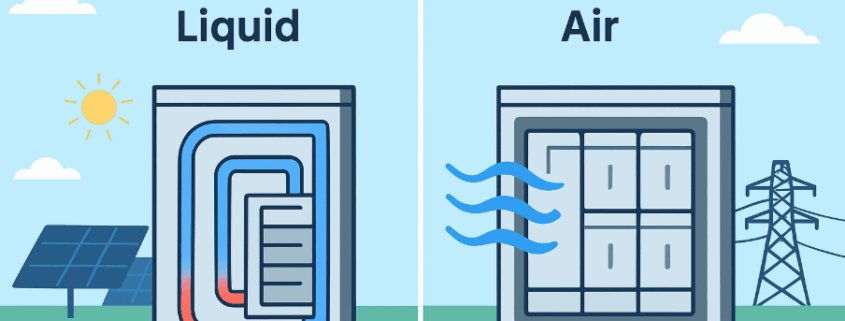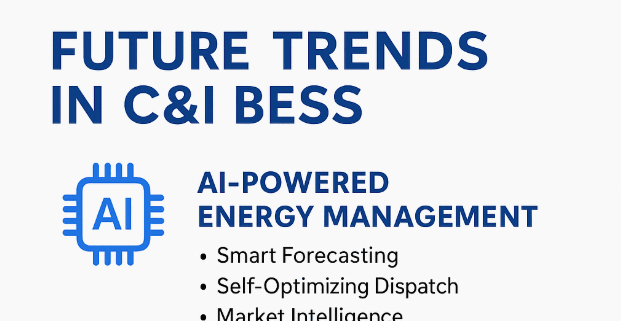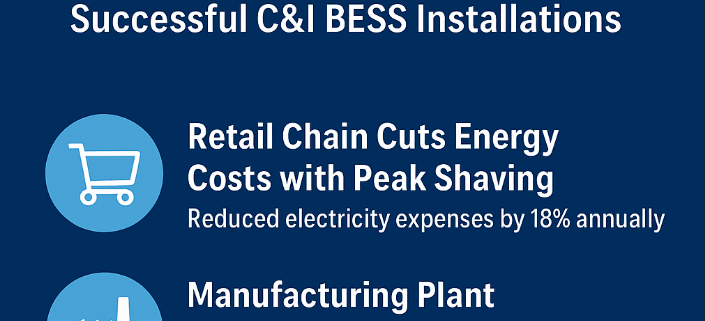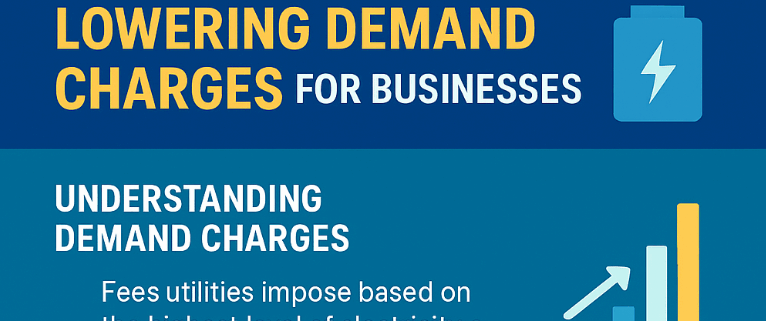UL 9540A Test Method: The Ultimate Guide for Battery Energy Storage Safety
UL 9540A Test Method: Battery Energy Storage Systems (BESS) are growing rapidly as renewable energy, electric vehicles, and grid-scale projects expand worldwide. While storage technology brings efficiency and sustainability, it also raises safety challenges—especially related to thermal runaway and fire propagation.
This is where the UL 9540A Test Method plays a vital role. It is the most widely accepted safety test for energy storage systems, referenced by codes such as NFPA 855 and the International Fire Code.
In this guide, we’ll explain:
- What UL 9540A is
- The four levels of testing
- How it relates to UL 9540 and UL 9540B
- The major 2025 updates
- Why manufacturers and project developers should care
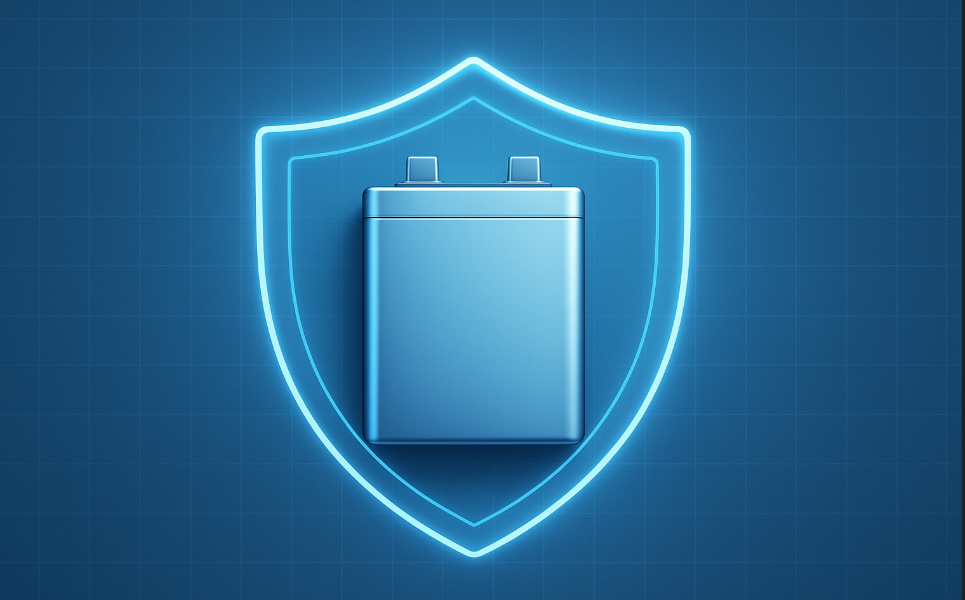
What is the UL 9540A Test Method?
The UL 9540A Test Method for Evaluating Thermal Runaway Fire Propagation in BESS is the only national standard designed to measure how battery systems react under thermal runaway conditions.
It answers critical safety questions such as:
- Will a single cell failure spread to neighboring cells?
- How will a battery module or system behave in case of fire?
- Can suppression systems prevent explosions, flames, or reignition?
Unlike general safety certifications, UL 9540A focuses only on fire propagation risks, making it the go-to test for engineers, installers, and regulators.
👉 Related: UL Certifications for Battery Systems
Why is UL 9540A Important for BESS?
Battery systems are often installed in homes, businesses, and utility-scale projects. If a fire starts and spreads, it can have devastating consequences. UL 9540A ensures that:
- Manufacturers can prove their systems are safe.
- Installers get clear installation requirements, such as spacing and suppression.
- Authorities have a reliable, consensus-based safety test.
It is directly referenced in NFPA 855, which governs the installation of stationary energy storage systems, making it essential for compliance.
👉 Explore more: CE for BESS: Complete Guide
The Four Levels of UL 9540A Testing
UL 9540A follows a hierarchical four-level structure. Testing may stop early if performance criteria are met.
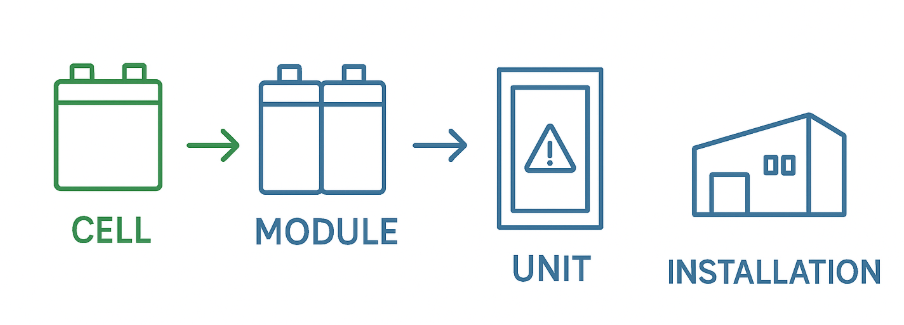
1. Cell-Level Testing
The test begins with individual cells. The goal is to induce thermal runaway and analyze gas emissions, flames, and heat release.
- If cells show no propagation risk, testing can stop here.
2. Module-Level Testing
If cell risks exist, groups of cells (modules) are tested. This step checks whether failures propagate across the module, creating larger hazards.
3. Unit-Level Testing
The full battery system (ESS unit) is tested. Suppression systems are often disabled unless they are built-in. Engineers assess:
- Flame spread
- Explosion risk
- Gas emissions
4. Installation-Level Testing
The final stage evaluates the system in real-world conditions with fire suppression included. It ensures:
- No detonation or deflagration
- Effective fire suppression
- No reignition after the event
👉 Related: What is BESS?
UL 9540A vs. UL 9540 and UL 9540B
It’s easy to confuse these standards, but they serve different purposes:
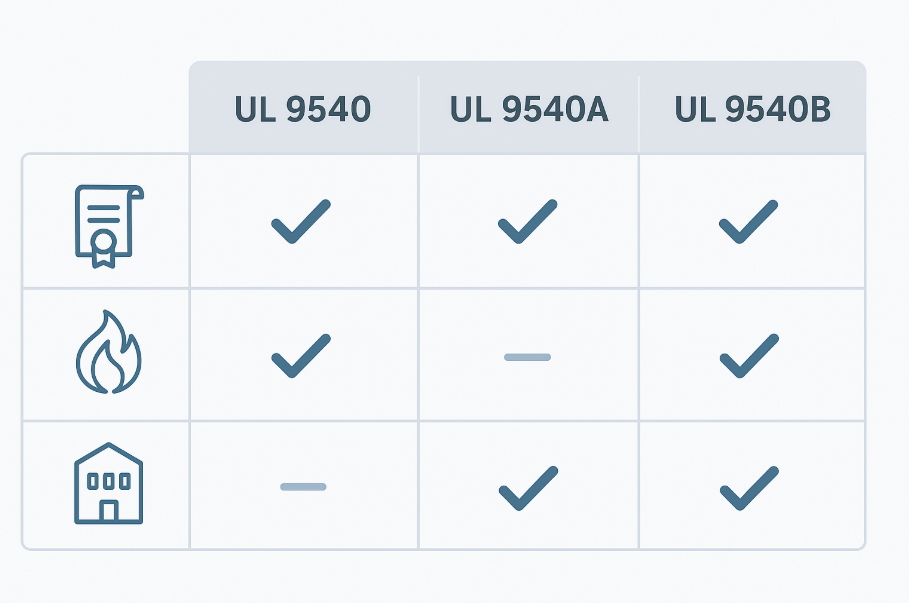
- UL 9540: Certification standard for energy storage equipment. Covers overall safety, performance, and compliance.
- UL 9540A: Test method for fire propagation in thermal runaway scenarios. Supports UL 9540 certification.
- UL 9540B: Designed specifically for residential-scale BESS, focusing on large-scale fire tests and vent gas ignition.
Together, these standards provide a complete safety framework for energy storage systems.
2025 Updates: What Changed in UL 9540A Fifth Edition?
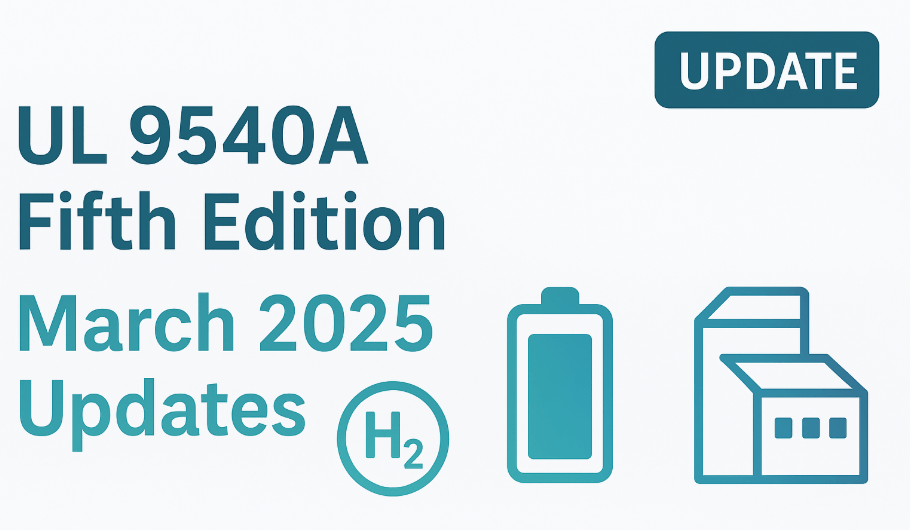
The fifth edition of UL 9540A, released on March 12, 2025, brings significant improvements to reflect evolving technology and chemistries.
Key Updates:
- Optional hydrogen detection and heat flux measurements.
- Clarified rest times after conditioning/charging.
- Replacement of NFPA 286 fire room with an instrumented wall for residential testing.
- More precise thermocouple placement and continuous ramping in cell tests.
- Specific temperature limits for module casings.
- Extended protocols for new chemistries like lead-acid, NiCd, and flow batteries.
- Added requirements for rooftop and open garage installations.
These updates make UL 9540A more adaptable, helping manufacturers meet stricter fire codes and regulators enforce safer installations.
👉 Related: Green Hydrogen Storage
Who Needs UL 9540A Testing?
UL 9540A applies to:
- Battery manufacturers – proving technology safety.
- BESS integrators – ensuring compliance with NFPA 855 and local fire codes.
- Developers and EPCs – gaining project approvals faster.
- Home and commercial installers – understanding spacing and suppression requirements.
Without UL 9540A testing, it becomes nearly impossible to get approval for large BESS installations in the U.S.
Benefits of UL 9540A Testing
- Compliance: Meets NFPA 855 and IFC requirements.
- Design Optimization: Provides data for safe spacing and fire suppression.
- Market Access: Required for many U.S. and Canadian projects.
- Risk Reduction: Lowers fire and explosion risks in installations.
Conclusion
The UL 9540A Test Method is the backbone of energy storage safety in 2025. With its updated fifth edition, it provides a clear, science-based framework to evaluate thermal runaway risks at cell, module, unit, and installation levels.
For manufacturers, passing UL9540A testing means faster certifications, safer designs, and wider market acceptance. For regulators and installers, it provides confidence that battery energy storage systems meet the highest safety standards.
As BESS technology evolves, UL 9540A will continue to be the key standard shaping how we store renewable energy safely and effectively.
👉 Learn more: UL Certifications for Battery Systems
FAQs: UL 9540A Test Method
Q1. What is the UL 9540A Test Method?
The UL 9540A Test Method is a fire safety test designed to evaluate the thermal runaway characteristics of battery energy storage systems (BESS). It helps manufacturers and system designers understand how a battery reacts under stress, including fire, gas release, and propagation risks.
Q3. How does UL 9540A differ from UL 9540 certification?
UL 9540 is a system-level certification for battery energy storage systems, while UL 9540A is a fire test method. UL 9540A is often used to provide supporting safety data required to achieve UL 9540 certification or to meet local fire codes.
Q2. Why is UL 9540A testing important for energy storage systems?
UL 9540A testing provides critical data for fire safety, helping system integrators, regulators, and building authorities approve energy storage projects. It ensures that batteries are safe for use in residential, commercial, and grid-scale installations.
Q4. What are the levels of UL 9540A testing?
UL 9540A includes four test levels:
- Cell level – Tests how a single cell behaves in thermal runaway.
- Module level – Examines propagation within a battery module.
- Unit level – Assesses fire and gas risks in the entire system.
- Installation level – Evaluates safety in a real-world installed environment.
For more details on BESS safety, see our guide on energy storage PCS.
Q5. Who requires UL 9540A testing?
UL 9540A testing is often required by:
- Battery manufacturers seeking UL 9540 certification.
- System integrators installing BESS in commercial or residential sites.
- Authorities Having Jurisdiction (AHJs) and fire marshals reviewing projects.
Learn more about BESS certifications required glo
Q6. What are the latest updates in UL 9540A (Fifth Edition, 2025)?
The March 2025 update to UL 9540A (5th Edition) added requirements for:
- Hydrogen detection sensors.
- Module casing integrity.
- Testing for rooftop energy storage systems.
Check our post on battery regulations in the EU for related compliance u
Q7. Does passing UL 9540A mean a battery is certified?
No, UL 9540A is not a certification. It is a test method that provides data used to achieve UL 9540 certification or to comply with fire codes. Certification comes from successfully meeting UL 9540 requirements.
Q8. How long does UL 9540A testing take?
The duration depends on system size and complexity. A full series of tests (cell, module, unit, installation) can take several weeks to months, depending on scheduling and regulatory requirements.
Q9. Can UL 9540A testing be skipped if a battery is already safe?
No. Even if a system has proven safety records, AHJs and certification bodies often require UL 9540A data as part of the approval process, especially for large-scale installations.
Q10. How does UL 9540A testing impact project approval timelines?
Providing UL 9540A data often accelerates permitting and approval by demonstrating compliance with NFPA 855, IFC, and local fire codes. Without it, projects may face delays or additional scrutiny.
Liquid vs Air Cooling System Use in BESS: Choosing the Right Thermal Management
Liquid vs Air Cooling System in BESS – Complete Guide: Battery Energy Storage Systems (BESS) are transforming how we store and manage renewable energy. But one often overlooked factor that determines their safety, performance, and lifespan is the cooling system. Effective thermal management ensures batteries operate within safe temperature ranges, preventing overheating, fire risks, and performance drops.
Among the various methods available, liquid cooling and air cooling stand out as the two most common approaches. Each has unique advantages, costs, and applications. In this post, we’ll compare liquid vs air cooling in BESS, and help you understand which method fits best depending on scale, safety, and compliance needs.
Why Cooling Matters in BESS
Battery cells generate heat during charging and discharging. If not managed properly, this heat can cause:
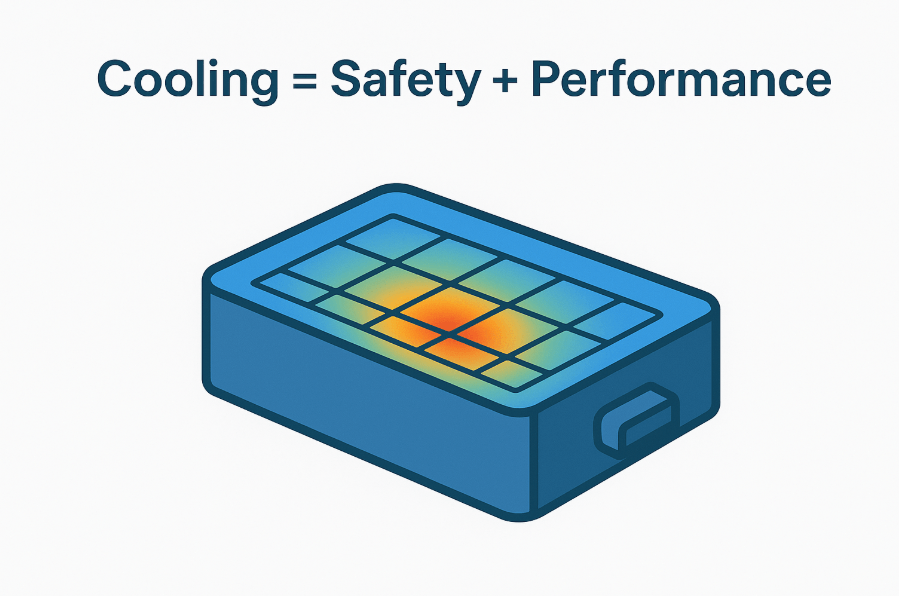
- Reduced battery efficiency
- Shortened lifespan
- Higher risk of thermal runaway
That’s why global standards such as UL certifications for battery systems and CE for BESS require strict compliance with safety and thermal management protocols.
Simply put: cooling = safety + performance.
Air Cooling Systems in BESS
Air cooling is the most widely used thermal management method in small to medium BESS setups. It works by blowing cool air across the battery racks with fans or forced ventilation.
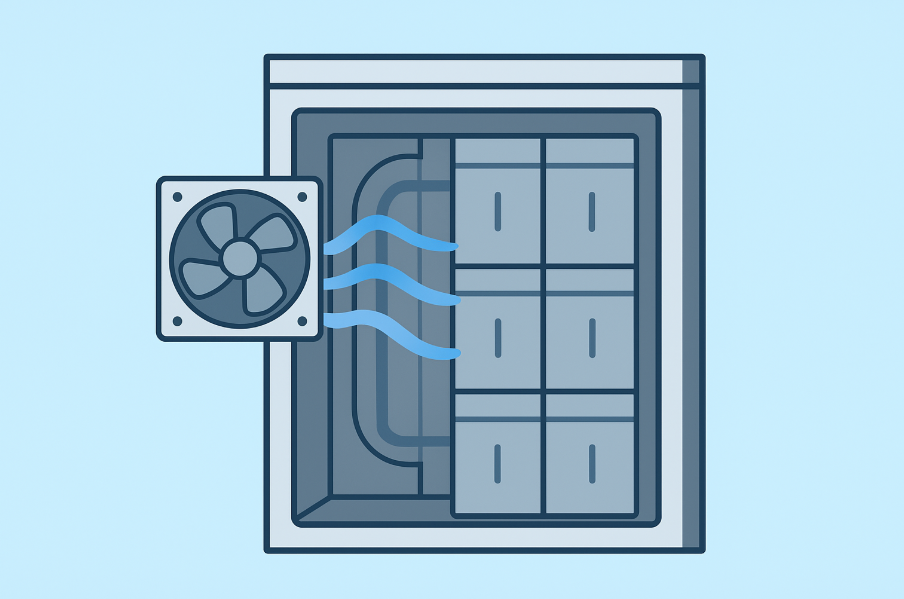
Advantages of Air Cooling
- Lower upfront cost
- Simpler system design
- Easier maintenance
Limitations of Air Cooling
- Less effective for high-density, utility-scale systems
- Struggles in hot or humid climates
- Uneven cooling across battery modules
Best Use Case: Residential or small commercial BESS paired with solar PV or EV charging.
Liquid Cooling Systems in BESS
Liquid cooling uses water-glycol mixtures or dielectric fluids circulated through cold plates or coolant channels around the battery cells. This method transfers heat more efficiently than air cooling.
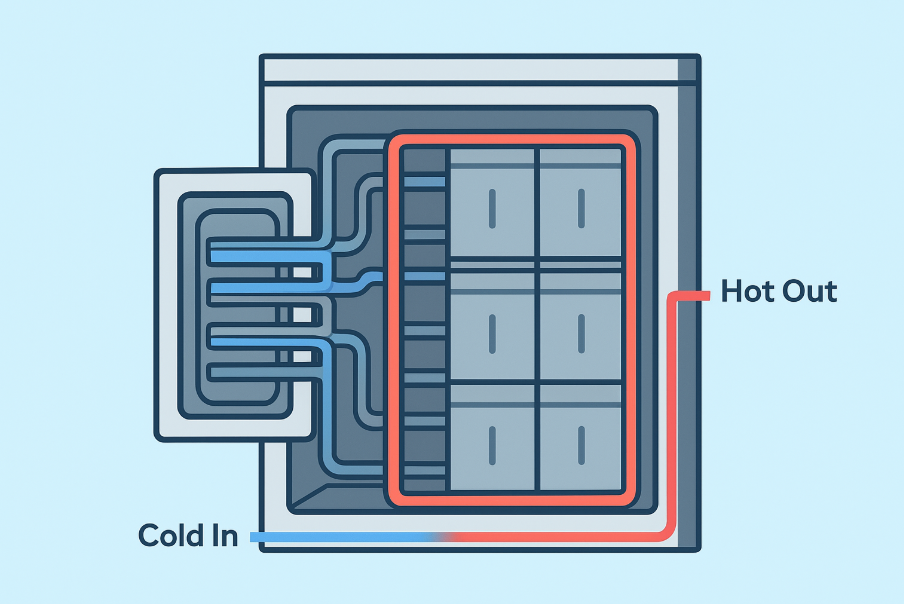
Advantages of Liquid Cooling
- High thermal efficiency
- Better temperature uniformity
- Ideal for grid-scale energy storage PCS and high-density BESS
- Scalable and safer in demanding climates
Limitations of Liquid Cooling
- Higher initial investment
- More complex installation and monitoring
- Requires leak-proof design and maintenance
Best Use Case: Utility-scale BESS, energy storage PCS integration, and applications requiring long-duration reliability.
👉 Learn more about Energy Storage PCS and how cooling supports PCS performance.
Liquid vs Air Cooling: Side-by-Side Comparison
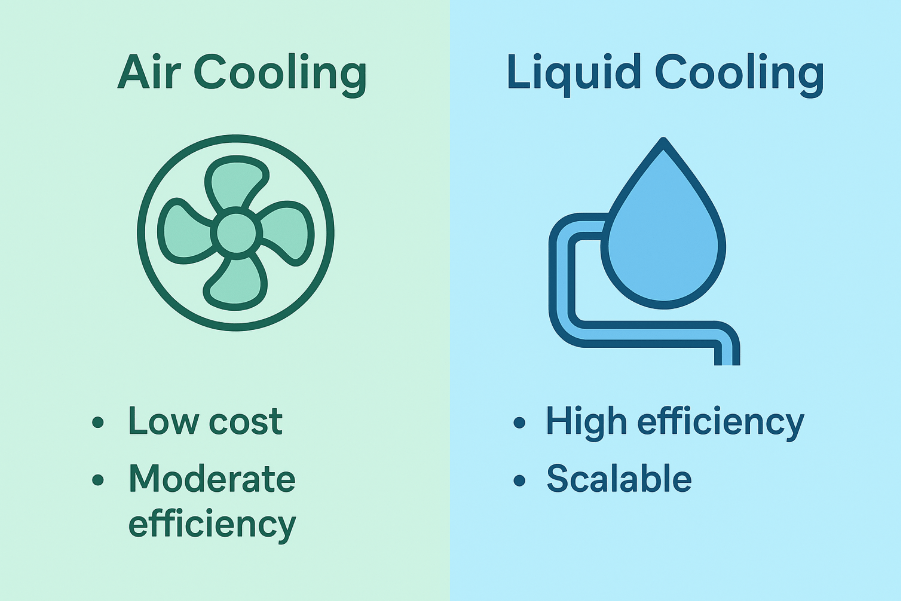
| Factor | Air Cooling | Liquid Cooling |
|---|---|---|
| Cost | Low | Higher |
| Efficiency | Moderate | High |
| Scalability | Limited | Excellent |
| Maintenance | Simple | Technical |
| Best for | Residential & small commercial | Utility-scale & grid applications |
In large-scale deployments, liquid cooling dominates due to higher efficiency and better safety margins. For smaller systems, air cooling remains cost-effective.
Cooling and Compliance
Thermal management directly influences regulatory compliance. Global frameworks such as:
- UL 9540 & UL 9540A for safety testing
- UL 9540A Test Method for thermal runaway evaluation
- CE certification for BESS in Europe
All emphasize the role of cooling in preventing fire hazards.
This makes cooling systems a critical design choice, not just an engineering afterthought.
Choosing the Right Cooling System
When selecting between liquid vs air cooling, consider:
- System Size: Larger BESS requires liquid cooling.
- Environment: Hot climates favor liquid systems.
- Cost vs Performance: Air cooling suits budget-sensitive projects.
- Compliance Needs: Regulatory approvals may depend on cooling efficiency.
For projects exploring advanced storage technologies such as green hydrogen storage, cooling strategies also play a role in integrated system safety.
Conclusion
The debate of liquid vs air cooling in BESS isn’t about which is better overall—it’s about which is better for your application.
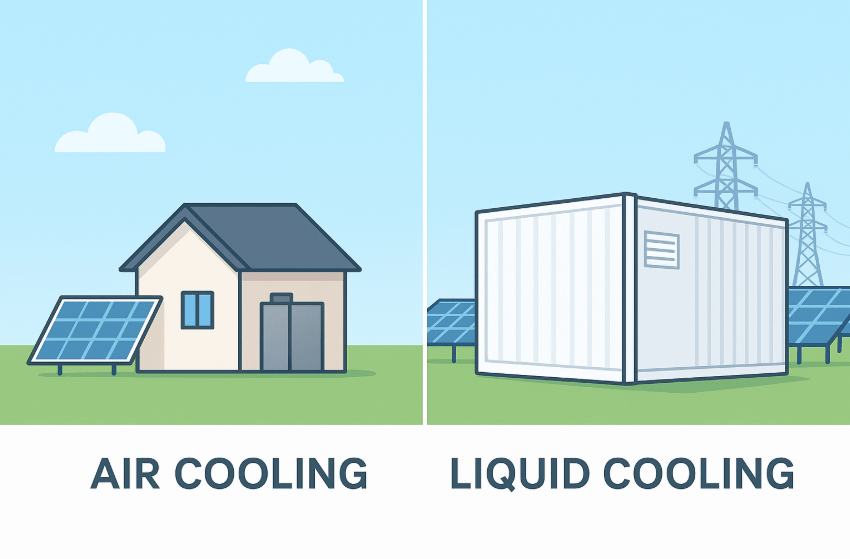
- Air cooling is cost-effective and simple for residential or small commercial setups.
- Liquid cooling is the gold standard for utility-scale, high-capacity BESS where safety, scalability, and compliance are critical.
As energy storage adoption grows, smart cooling design will define the future of battery system safety and efficiency.
FAQs – Liquid vs Air Cooling in BESS
1. What is the difference between liquid and air cooling in BESS?
Air cooling uses fans to move air across battery modules, while liquid cooling uses fluids circulated through channels or plates to absorb heat more effectively.
2. Which cooling system is better for large-scale BESS?
Liquid cooling is preferred for utility-scale and high-density BESS because it provides superior thermal management, reduces hot spots, and improves safety.
3. Is air cooling still used in modern BESS?
Yes, air cooling is still used in residential and small commercial BESS where costs are lower and power density is moderate.
4. How does cooling affect battery safety?
Proper cooling reduces the risk of overheating and thermal runaway. Standards like UL 9540A Test Method specifically evaluate how BESS cooling impacts fire safety.
5. Does cooling impact regulatory compliance for BESS?
Yes. Certifications such as UL certifications for battery systems and CE for BESS require effective thermal management to meet safety standards.
6. Which cooling system is more cost-effective?
Air cooling is more affordable upfront. However, liquid cooling may deliver better long-term value by extending battery lifespan and ensuring compliance in large-scale systems.
✅ Next Step: Learn more about Energy Storage PCS and how Sunlith Energy helps integrate cooling with PCS design for optimal BESS performance.
C&I BESS Thermal Management: Optimizing Performance, Safety & Lifespan
C&I BESS thermal management is a foundational aspect of creating a robust, safe, and high-performing Battery Energy Storage System. As SunLith highlights in their Key Components of a C&I BESS article, maintaining the right operating temperature via thermal systems dramatically reduces risks of overheating and battery degradation.
Effective thermal control not only prevents thermal runaway and improves safety—but also extends battery lifespan and operational efficiency.
Why Thermal Management Matters
Temperature extremes significantly impact battery performance. High heat accelerates wear and increases fire risk; cold slows reaction rates and lowers efficiency.
With proper thermal control, a C&I BESS achieves:
- Enhanced safety and fire mitigation
- Consistent performance and capacity
- Extended system lifespan and reliability
Key Components of Thermal Management
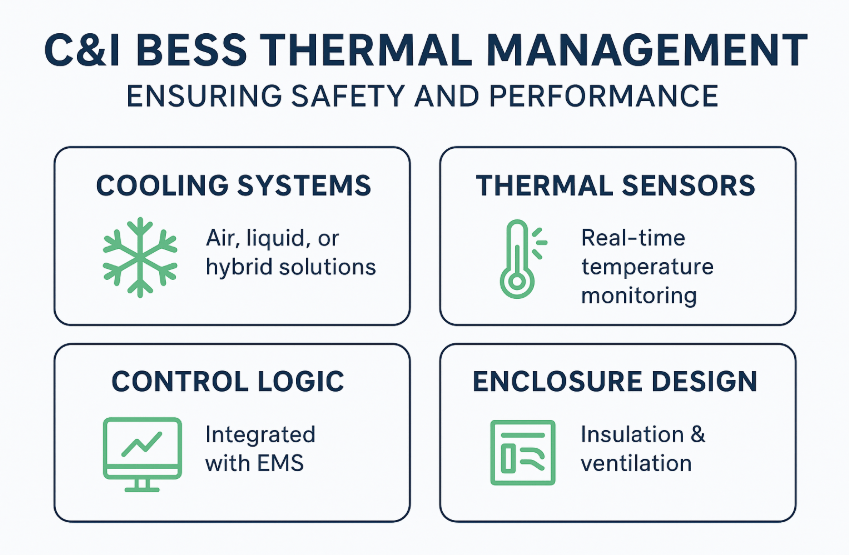
A robust thermal management system within a C&I BESS typically includes:
- Cooling Systems: Air, liquid, or hybrid solutions tailored to system scale
- Thermal Sensors: Providing real-time temperature data for EMS response
- Control Logic: Integrated into EMS to automate cooling actions
- Enclosure Design: Providing insulation with airflow control and heat dissipation
These align with SunLith’s component breakdown in their Key Components of a C&I BESS article.
Cooling Strategies for C&I BESS
| Approach | Best For | Pros | Trade-Offs |
|---|---|---|---|
| Air Cooling | Small to medium-scale | Cost-effective and simple | Less efficient in dense setups |
| Liquid Cooling | High-density, heat-intensive systems | Exceptional heat control | Higher cost, maintenance needs |
| Hybrid Systems | Critical applications | Redundancy + efficiency | Complex system design |
Markets are increasingly favoring liquid and hybrid cooling for enhanced safety in large C&I BESS projects.
Performance, Safety & Regulatory Compliance
Consistent thermal regulation contributes to enhanced charge/discharge efficiency and durability. Regulatory standards such as UL 9540A and IEC 62933 emphasize the importance of thermal protection in ensuring BESS safety certification—reinforced in SunLith’s insights into safety protocols.
Learn more about C&I BESS Safety Standards at SunLith Energy
Trends in Thermal Management
The future of C&I BESS thermal management incorporates:
- AI-Enabled Cooling Control: Predicting heat patterns and adjusting cooling dynamically
- Phase-Change Materials (PCM): Buffering peaks in heat passively
- Liquid Immersion Cooling: Advanced, high-efficiency thermal control for dense systems
These advancements are key building blocks for safer and longer-lasting energy storage.
Conclusion
C&I BESS thermal management is not a luxury—it’s a critical pillar for safety, efficiency, and longevity. A SunLith-style system uses innovative cooling, real-time monitoring, and smart control to unlock full potential. By integrating these best practices, businesses ensure their BESS assets remain secure, efficient, and future-ready.
FAQs
Q1: What is C&I BESS thermal management?
A: C&I BESS thermal management refers to the systems and controls that keep battery modules within safe operating temperatures (cooling, sensing, and control). Proper thermal management ensures consistent performance, reduces degradation, and prevents overheating-related safety incidents.
Q2: Why is thermal management important for C&I BESS?
A: Temperature extremes shorten battery life and raise safety risks (including thermal runaway). Good thermal management improves efficiency, extends lifespan, and reduces maintenance and insurance costs.
Q3: What are the common thermal management methods?
A: Typical approaches are air cooling, liquid cooling, and hybrid systems. Advanced options include phase-change materials (PCM) and liquid immersion for very high-density systems.
Q4: How does thermal management extend battery lifespan?
A: By keeping cell temperatures in the optimal range, thermal systems slow chemical degradation, reduce capacity fade, and enable more charge/discharge cycles — all of which improve lifecycle economics.
Q5: Can thermal management prevent thermal runaway?
A: It significantly reduces the probability and severity of thermal runaway by removing excess heat early, enabling the BMS and EMS to act, and triggering suppression/venting when needed.
Q6: What’s the difference between air cooling and liquid cooling?
A: Air cooling is simpler and lower cost, best for small–medium systems. Liquid cooling offers much better heat transfer for high-density, continuous-duty C&I installations but has higher complexity and maintenance needs.
Q7: How does thermal management integrate with an EMS?
A: Thermal sensors feed real-time temperature data into the EMS, which then adjusts dispatch and cooling setpoints proactively. See our Key Components of a C&I BESS guide.
Q8: Which safety standards relate to thermal control in C&I BESS?
A: Important standards include UL 9540/9540A, IEC 62933, and local fire codes. For more details, see our C&I BESS Safety Standards.
Q9: How often should thermal systems be inspected and serviced?
A: Routine inspections are typically quarterly or semi-annual. Tasks include sensor calibration, coolant checks/pumps, filter replacement, and EMS updates. High-risk or 24/7 sites should use predictive maintenance.
Q10: How does thermal management affect the economics of C&I BESS?
A: Better thermal control reduces replacement and downtime costs, improves efficiency, and increases usable lifetime — all of which improve C&I BESS economics
Future Trends in C&I BESS — AI, Smart Grids & Next-Gen Chemistries
C&I BESS future trends are rapidly advancing, reshaping how businesses manage energy. As seen in the SunLith blog’s recent overview of renewable integration challenges and solutions, the next generation of C&I Battery Energy Storage Systems (BESS) goes well beyond solar, wind, and basic load shifting SunLith Energy. Forward-looking enterprises are now embracing smart energy flows through AI, grid interaction, advanced chemistries, enhanced safety, and sustainability to unlock new benefits.
Trend 1: AI-Powered Energy Management Systems
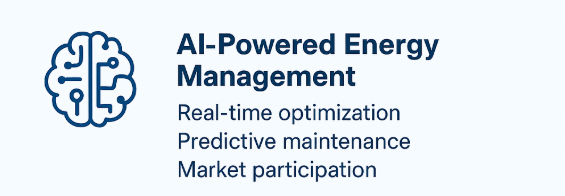
AI is transforming the Energy Management System (EMS) that lies at the heart of every C&I BESS:
- Smart Forecasting anticipates renewable generation and load peaks.
- Self-Optimizing Dispatch dynamically times charge/discharge for cost and efficiency.
- Market Intelligence enables real-time participation in demand-response and energy arbitrage.
This trend directly links to the EMS component in our earlier “Key Components” post for seamless integration.
Trend 2: Greater Smart Grid Integration

As SunLith points out, powering microgrid autonomy is crucial for renewable alignment SunLith Energy. Future C&I BESS systems will:
- Instantly counter grid fluctuations through two-way communication.
- Enable microgrids to operate independently during outages.
- Facilitate virtual power plant (VPP) networks, aggregating storage across sites.
These features bolster both reliability and system flexibility.
Trend 3: Next-Generation Battery Chemistries

Lithium-ion dominates today—but tomorrow’s storage will include:
- Solid-State Batteries: higher density with enhanced safety.
- Flow Batteries: ideal for extended-duration, modular storage.
- Sodium-Ion & Hybrid Cells: cost-effective and resource-abundant options.
These chemistries will support long-duration applications and reduce resource constraints.
Trend 4: Enhanced Safety & Compliance
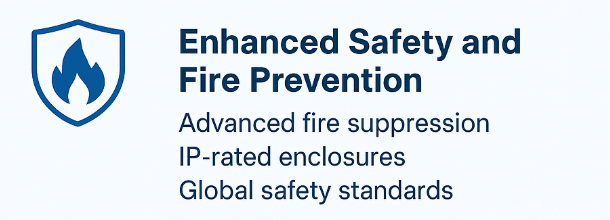
With rapid market growth (projected BESS reaching 500 GW by 2031) comes increased focus on safety standards SunLith Energy. Upcoming trends include:
- AI-enabled early detection and fire suppression systems.
- IP-rated enclosures for robust environmental protection.
- New certification standards—addressing fire, enclosures, and operational resilience.
Safety now intersects deeply with innovation and performance.
Trend 5: Sustainability, Second-Life & Circularity
Sustainability is central to future C&I BESS design:
- Second-Life Batteries (e.g., retired EV packs) are gaining traction for cost-effective reuse.
- Circular design and recycling strategies will reduce lifecycle impacts.
- Eco-friendly chemistries and lower resource footprints align with ESG goals.
These trends make energy storage not just smart, but also sustainable.
Business Implications of C&I BESS Future Trends
Adopting these trends provides tangible business advantages:
- Improved ROIs through intelligent dispatch and grid revenue.
- Operational independence, especially with smart grid and microgrid support.
- Alignment with decarbonization mandates and sustainability strategies.
Integrating these advancements reinforces your energy infrastructure for years to come.
Conclusion
The evolving landscape of C&I BESS future trends—from AI-powered EMS and smart grid integration to advanced chemistries and circular strategies—is setting the stage for next-level energy storage. As energy complexity rises, businesses must keep pace. Staying at the forefront of these innovations ensures operations that are efficient, resilient, compliant, and sustainable.
Explore how these trends tie into our earlier deep dives on EMS components and renewable integration for a cohesive energy strategy.
Real-World Case Studies: Successful C&I BESS Installations
C&I BESS case studies provide powerful proof of how energy storage systems deliver measurable benefits in commercial and industrial settings. By examining successful deployments, businesses can see real-world evidence of cost savings, resilience improvements, and renewable energy integration. This article showcases real-life examples across industries, linking back to applications of BESS and the economic benefits of deployment.
Case Study 1: Retail Chain Cuts Energy Costs with Peak Shaving
A large retail chain in the U.S. adopted a C&I BESS to manage demand charges. By reducing peak load, the business cut electricity expenses by 18% annually. The system also provided backup power during outages, improving reliability.
Key Outcome: Cost savings + resilience.
Case Study 2: Manufacturing Plant Improves Power Quality
An industrial manufacturer in Germany faced frequent voltage fluctuations, disrupting operations. A 5 MWh BESS was deployed to stabilize the grid connection and smooth load profiles. The plant saw reduced downtime and higher operational efficiency.
Key Outcome: Enhanced power quality + productivity.
Case Study 3: Data Center Achieves 24/7 Uptime
Data centers require uninterrupted power. A Singapore-based data center installed a C&I BESS as part of its microgrid. The system ensured seamless switchover during grid disturbances, protecting sensitive equipment and avoiding costly downtime.
Key Outcome: Reliability + continuous operations.
Case Study 4: Winery Integrates Solar with Storage

A California winery combined its solar array with a 2 MWh C&I BESS. The system shifted solar energy into evening hours, reducing grid dependency and supporting sustainability goals. Seasonal operations benefited from greater flexibility.
Key Outcome: Renewable integration + sustainability.
Case Study 5: Hospital Increases Energy Resilience
Hospitals must prioritize uninterrupted energy supply. A hospital in Australia deployed BESS alongside diesel generators. The hybrid system provided critical backup, reduced fuel costs, and aligned with green initiatives.
Key Outcome: Energy security + reduced emissions.
Lessons Learned from C&I BESS Case Studies
Across these case studies, common success factors emerge:
- Peak shaving and demand charge reduction directly improve the bottom line.
- Improved resilience and power quality safeguard operations.
- Integration with renewables aligns with sustainability and ESG goals.
- Scalability and flexibility make BESS suitable across diverse industries.
Conclusion
Real-world C&I BESS case studies demonstrate the versatility and value of energy storage. From retail and manufacturing to data centers and healthcare, businesses are achieving cost savings, operational resilience, and sustainable energy strategies. Companies evaluating storage can learn from these successes and explore how C&I BESS can strengthen their operations.
For deeper insights, revisit the applications of C&I BESS, the benefits, and the economics of deployment
How C&I BESS Reduces Demand Charges Through Peak Shaving
C&I BESS peak shaving is rapidly becoming one of the most effective strategies for commercial and industrial (C&I) facilities to lower electricity costs. By leveraging battery energy storage systems (BESS), businesses can reduce demand charges, optimize energy usage, and unlock significant long-term savings.
Understanding Demand Charges
Demand charges are fees utilities impose based on the highest level of electricity a facility consumes during a billing cycle. For businesses with large equipment or fluctuating energy needs, these charges often make up 30–70% of total electricity bills.

How Peak Shaving Works with C&I BESS
- Monitoring Usage: Smart systems track real-time energy demand.
- Battery Discharge: During peak load times, stored energy is released to reduce grid reliance.
- Lower Peak Demand: Utilities see a reduced maximum load, leading to lower demand charges.
This process allows companies to maintain operations while avoiding costly spikes in utility bills.

Financial Benefits of Peak Shaving
Implementing C&I BESS peak shaving delivers measurable financial benefits:
- Reduced Utility Costs: Lower peak demand translates to smaller monthly bills.
- Faster Payback Period: Cost savings accelerate ROI for BESS investments.
- Predictable Expenses: Businesses can forecast energy costs with greater accuracy.
👉 See our post on C&I BESS Economics to explore ROI in more detail.
Operational Benefits Beyond Cost Savings
While financial returns are the most visible, peak shaving also provides operational advantages:
- Improved Energy Reliability during high-demand periods.
- Optimized Equipment Usage by reducing grid strain.
- Increased Flexibility for energy-intensive operations.
👉 Learn more about the broader Benefits of C&I BESS, including resilience and sustainability.
Case Example: Peak Shaving in Manufacturing
A large manufacturing facility with heavy machinery faced monthly demand charges of over $50,000. By installing a 5 MW / 10 MWh C&I BESS, the facility:
- Cut demand charges by 35%.
- Saved over $500,000 annually.
- Recovered the investment within 4 years.
Future Outlook: Peak Shaving as a Business Imperative
As electricity rates rise and utilities implement more time-based pricing, C&I BESS peak shaving will shift from an optional strategy to a business necessity. Companies adopting this approach early will gain a competitive advantage in cost control and sustainability goals.
Conclusion
C&I BESS peak shaving is a proven solution to reduce demand charges, optimize energy use, and drive long-term savings. For businesses in manufacturing, retail, healthcare, or data centers, investing in battery storage is not just about energy—it’s about financial resilience and operational efficiency.


